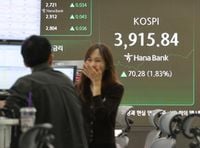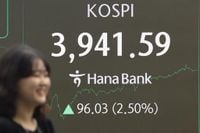South Korea’s financial markets have been swept up in a wave of optimism, with the country’s main stock index, the Kospi, surging to a record high on October 24, 2025. The index closed at 3,941.59, up 2.5% or 96.03 points from the previous session, putting it within striking distance of the symbolic 4,000 mark—a milestone that seemed almost unthinkable just months ago. The rally, fueled by powerful gains in semiconductor and battery shares, has mirrored a broader sense of hope across Asia’s equity markets, as investors look to a possible thaw in US-China trade relations and the global resurgence of technology stocks.
The mood in Seoul’s trading rooms was buoyant as screens flashed the Kospi’s new all-time highs. According to MT Newswires, the surge was underpinned by renewed confidence that the longstanding US-China trade dispute might finally see some resolution. This optimism was stoked by news that US President Donald Trump and Chinese President Xi Jinping are scheduled to meet in Gyeongju, South Korea, on October 30. It will be their first face-to-face meeting since Trump’s second term began, and it comes at a critical juncture: a potential 100% US tariff hike looms on November 1, and a pivotal trade truce is set to expire on November 10.
Investors are clearly betting that the summit could avert a damaging escalation in tariffs and set the stage for renewed trade flows, which are vital for export-driven economies like South Korea. The Kosdaq, South Korea’s small-cap index, also benefited from the upbeat sentiment, rising 1.3% to 883.08. The South Korean won strengthened slightly to 1,434.7 against the dollar, though the currency remains volatile, having dropped more than 4% against the greenback over the past three months. The country’s finance ministry signaled its readiness to step in should further stabilization be needed.
The rally was led by the semiconductor giants that have come to define South Korea’s economic might. SK hynix, the world’s leading supplier of high-bandwidth memory chips crucial for artificial intelligence applications, saw its shares jump 6.58% to 510,000 won. This marked the first time the stock closed above the 500,000 won level since joining the SK Group. Samsung Electronics, the other titan of the sector, gained 2.38% to 98,800 won, inching ever closer to the fabled 100,000 won milestone. Together, these two companies’ combined market capitalization soared past 1 quadrillion won ($709 billion), nearly doubling from a year earlier. As Korea JoongAng Daily reported, this milestone underscores the dominance of semiconductor stocks in driving the Kospi’s ascent.
Battery makers joined the charge, with LG Energy Solution surging 9.94% and Samsung SDI climbing 13.57%. Analysts, such as Kim Woon-ho of IBK Investment & Securities, noted, “Given that memory chip demand is more stable than during the 2018 boom, valuations for Samsung Electronics and SK hynix need to be reassessed.” Park Jin-soo of Shinyoung Securities added that LG Energy Solution is filling production gaps with new orders, despite facing risks in the US market, and that Samsung SDI’s local production of energy storage system batteries is expected to boost European sales in the coming quarters.
Not all sectors shared equally in the euphoria. Hanwha Aerospace fell 3.43%, Kia slipped 0.09%, and KB Financial Group dropped 0.87%. In the financial sector, BNK Financial Group and KB Financial Group saw modest earnings upgrades but still lost ground, reflecting ongoing caution about interest rate trends.
The Kospi’s sharp rally began after it broke the 3,800 level just five trading days earlier, a testament to the market’s strong momentum. As The Korea Economic Daily highlighted, the index even hit an intraday high of 3,951.07 on October 24, another record. Market strategists are already looking ahead, with Kim Tae-hong, chief executive of Growth Hill Asset Management, suggesting, “If the Kospi’s forward 12-month price-to-earnings ratio returns to its previous peak of 13 times, the index could rise to 4,400.”
Outside the tech sector, some analysts see opportunities for funds to rotate into other industries as third-quarter earnings season unfolds. APR Co., a fast-growing skincare brand operator, and entertainment powerhouse YG Entertainment have both seen upward revisions in profit forecasts. According to market tracker FnGuide Inc., APR’s third-quarter revenue and operating profit are estimated at 370.9 billion won and 85.9 billion won, respectively, with US and European sales surging by 238% and 297% year-over-year. YG Entertainment, buoyed by the ongoing world tour of girl group Blackpink and anticipation for boy band Big Bang’s 20th-anniversary album, is expected to post a third-quarter operating profit of 32.5 billion won, up 20.6% from earlier projections. Yet, both companies’ shares have declined this month as foreign investors have poured over 90% of fund inflows into semiconductor stocks.
LG Display, another stalwart of South Korea’s export economy, is also poised for a strong third quarter. Market consensus puts its operating profit at 440.4 billion won, an 80% increase from projections three months ago, thanks to rising OLED panel shipments for Apple devices. However, like APR and YG, LG Display’s shares have dipped as investors lock in gains and rotate capital.
Globally, the optimism wasn’t confined to Seoul. Other Asian markets moved higher on October 24, with Japan’s Nikkei 225 up 1.35% to 49,299.65, China’s Shanghai Composite Index gaining 0.71%, and Hong Kong’s Hang Seng Index rising 0.77%. In the US, all three major indices closed higher the previous day, buoyed by strong earnings from tech leaders such as Intel, Nvidia, Broadcom, and Amazon. Intel’s third-quarter revenue of $13.65 billion, which exceeded expectations, was widely cited as a spark for the global “AI rally.”
Bond markets saw yields edge higher, with the yield on South Korea’s three-year Treasurys rising to 2.61% and five-year government bonds to 2.72%. The won-dollar exchange rate remained somewhat volatile, quoted at 1,436.85 at 3:30 p.m. local time, down 2.5 won from the previous session.
As the Kospi edges ever closer to the 4,000 mark, the big question is whether this chip-fueled rally can broaden out to other sectors or if it will remain a two-chip story dominated by Samsung and SK hynix. The coming weeks, with high-stakes trade talks and a packed earnings calendar, will go a long way toward answering that question. For now, South Korea’s markets are basking in a rare moment of optimism, with investors daring to hope that the worst of the trade turbulence may finally be behind them.


